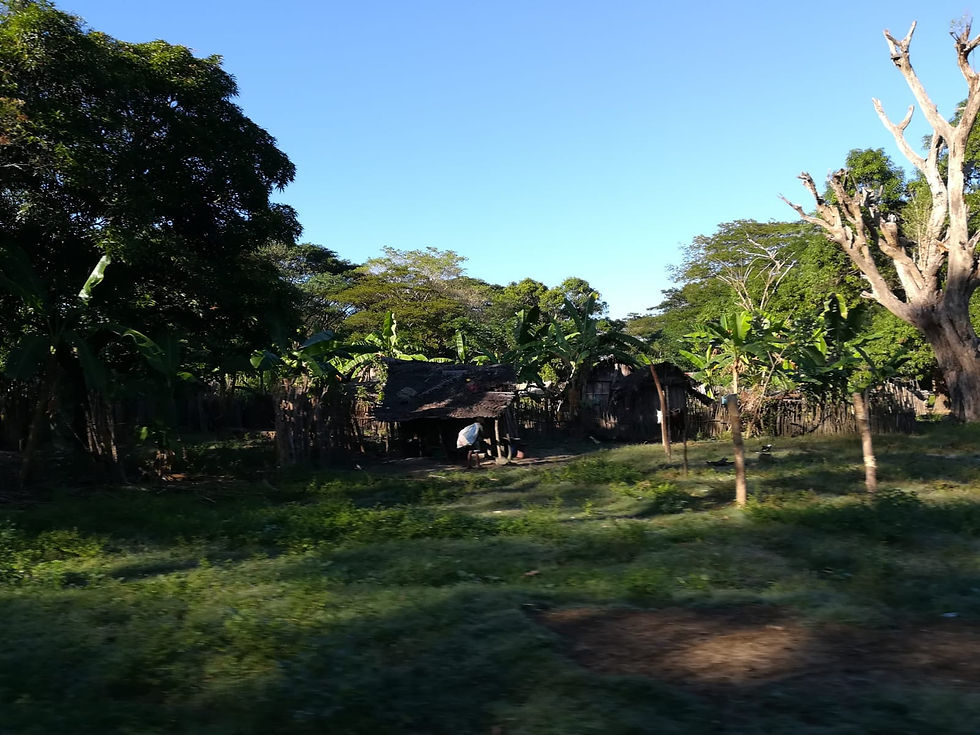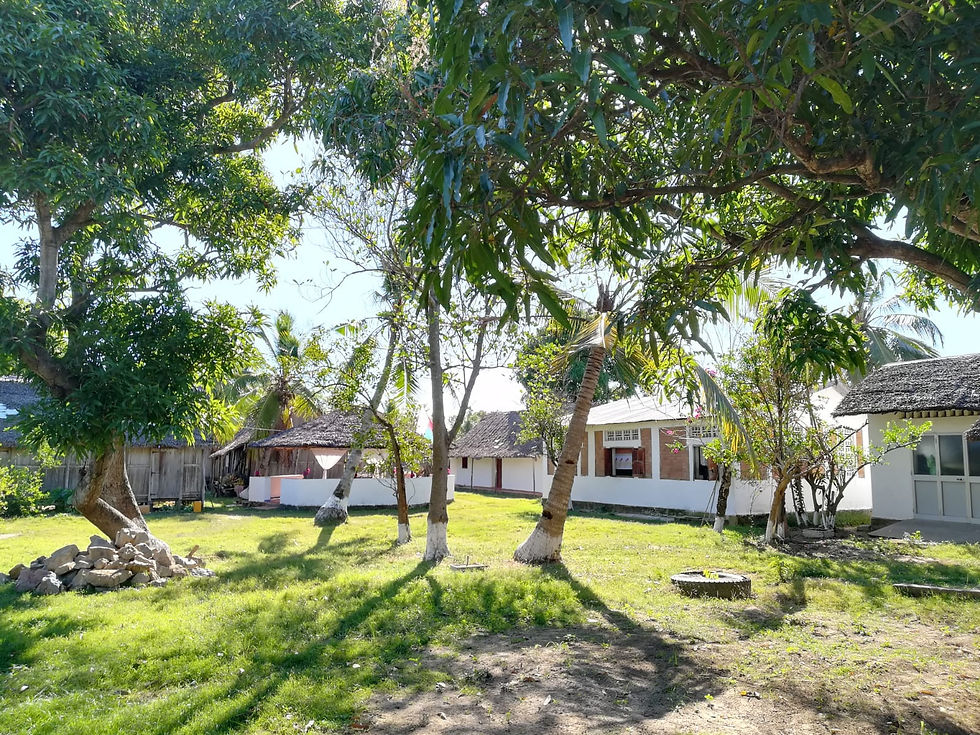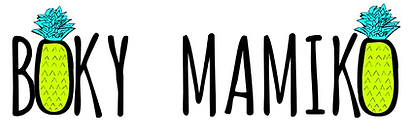Day 1 in Djangoa: our adventure begins!
- Boky Mamiko Team
- Jun 9, 2018
- 5 min read
Updated: Jun 18, 2018
Hi everyone! We'd like to share our first impressions of Djangoa and the École Mamiko with you. As you'll see, we have quite many impressions, so please excuse the heavy text-load...
Journey to Djangoa:
Early in the morning, which is to say at 4.30 a.m., we left Nosy Be to go to Djangoa. It was quite a challenge to fit 2 small suitcases, 2 ordinary backpacks, and 5 big and heavy suitcases as well as ourselves - Geneviève, Domi, and Sarah - into one taxi. Heavily loaded, we drove to the port in Hellville, from where we took a boat to Ankify. At the port in Hellville, we - Domi and Sarah - felt like tourist attractions because some people took pictures of us - we indeed stood out from the other passengers, who were all local people. We enjoyed the boat transport, seeing other, smaller islands than Nosy Be (which means "big island"), and dozing off a bit. Our heavy luggage presented an opportunity to gain some extra money for the people working at the ports. Someone even shouldered a 32 kg suitcase, which we already found too heavy to carry up and down stairs. Impressed! We took another taxi in Ankify. The trunk was not even big enough for half of our luggage, but somehow the driver was able to pile up our luggage and fixed them with ropes. Our first drive on the "real" island of Madagascar led us through a huge cocoa plantation. Maybe our "original Swiss Made" Chocolate has its origins in Madagascar..?
We stopped in Ambanja, the capital of the district, to buy some basic things to start with: bottled water, rice, tomatoes, potatoes, fruits, Malagasy SIM Cards etc. The supermarket already made us want to try as much of the local food as possible and also made us wonder how many different types of fruits, roots and rice grow here..
After another 45 minutes drive we finally arrived in Djangoa!
Tuonga sua Djangoa / Bienvenue à Djangoa:
First impression? To be honest: sobering. Way more people than expected, lots of stares, lots of destroyed houses due to the hurricane in March (see section "News") and built side by side, leaving only little space to breathe. We drove on narrow dirt roads (also made of sand that was brought with the mud from the storm) through Djangoa, being astonished about the firmness of the car and the self-confidence of the taxi driver. But as we arrived at our new home our mood brightened up immediately.
Geneviève's family built themselves a sweet little area of living. There is Gene's house, her parents' house, her sister Valentine's house and the house where we volunteer students live. And in between: a big beautiful garden! You'd like to eat a banana? No problem, just take one from the garden. Orange, mango, coconut, lime, cinnamon, jack fruit, breadfruit, tomato? You name it, their garden's got it. Amazing!
Let's get to Gene's family. First of all, there's Valentine, Gene's sister. During the hurricane, the house where we live in was not destroyed like most of Djangoa, but was severly damaged due to the flood. Valentine worked for two months to renew the house, remove the mud, paint the walls, install the beds and make it comfortable for us. She even decorated the beds and the terrasse with flowers. And she cooks for us... Have you ever had Malagasy cuisine? You should try it either way but when Valentine's the cook, you must definitely not miss it. Very delicious!
Then there are Lisa (her sister and school director), Émilien and Délphine (her parents) and of course a lot of sweet kids that always accompany us. The family is great, they introduced us to all the neighbours and the communal chiefs, serve us their garden's fresh fruit and teach us Malgasy. It's ubelievable how the local people appreciate being greeted in Malgasy by (really) white Europeans: Mbala Tsara - Mbala Tsara - Tsareeee! Funny language and greeting routine!
Mbala Tsara École Mamiko:
In the afternoon we visited the school École Mamiko for the first time. The kids were already waiting for us and welcomed us very warmly with a rehearsed "Bonjouuur Madame Sarah, Bonjouuur Monsieur Dominic" in every classroom. What a great surprise! While the kids were very enthusiastic and happy to see us, the teachers seemed somehow reserved and even a bit unhappy about our arrival. For a short moment we - Sarah and Domi - were somewhat insecure: are the teachers in favor of this project? Or were they just told that this would happen without them being involved? Fortunately, we had a meeting with them after the community meeting...
The École Mamiko - Boky Mamiko merger:
The goal of the meeting was to get to know each other and share mutual expectations. The previous impression about the teachers being passive, disinterested or even against the library project was fortunately not confirmed. They all said that they are proud to be involved in the library project and that they find it difficult to speak French. The mistery was solved: they've been reserved because they don't feel comfortable speaking French, not because they're against the project. We emphasized several times that this will be team-work and that French isn't our mother tongue either, so we hope to build the project in collaboration with them. Conclusion: everyone left in good mood and with thirst for action!
During the meeting, some children sat at the classroom tables, like we did. After a certain time, they sat behind me - Sarah - and started to poke and touch my arms. They somewhat tried to find out how (very) white skin feels... When we left the classroom, they also took my hands to walk home. For me, this was a strange and at the same time touching experience.
The community meeting:
Geneviève, Lisa, the teachers and Émilien organized a community meeting with the school children's parents and other children's parents in order to reinforce the importance of education and in order to inform them about the Boky Mamiko project. Lisa, Geneviève and Émilien were the main speakers. To our - Sarah's and Dominic's - surprise, two men spoke too. They thanked the École Mamiko and Boky Mamiko teams, especially Geneviève (for giving so much back to the place where she grew up) for their/our efforts in improving the accessibility and quality of education in Djangoa. They both emphasized that the school's quality is very special and impressive, particularly because Djangoa is a rural town and because parents don't pay as much as for other private schools with lower quality. This is exactly why the school was founded: in order to avoid that children are sent elsewhere for schooling and in order to make good education more accessible. For us, it was very impressive and touching that the community, represented by the 2 speakers, appreciates this so much. Since the meeting was held in Malagasy, we were first unsure whether the men pronounced themselves in favor or against the library project. We only felt that tension was building up. But after a certain time, people smiled, laughed, and even clapped, so we were assured that the tension was actually positive. This was confirmed by Genevièves' intermediary translations. After the meeting, women also approached Gene and Lisa, expressing their gratefulness. Geneviève told us that the children had told their parents to arrive punctually to the meeting, which shows that for the children, everything concerning the school and the new library is of great importance.
What a day, what a start to our project! We'll keep you updated, hope to see you soon! June 8, Domi and Sarah
















Thank you for sharing your pioneer work with us! I am so excited to hear all your great stories. So please keep on writing. Good luck!
Glad to see you're settling in Djangoa nicely!! The pictures look amazing, can't wait to join you soon!!